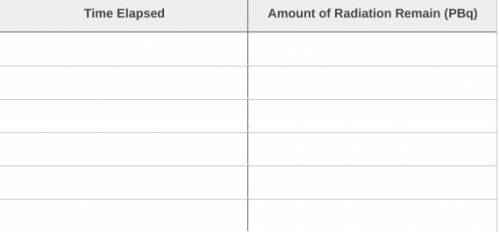Mhanifa help please!
Read the article:
Chernobyl Disaster
The Chernobyl disaster was a...

Chemistry, 25.04.2021 01:00 aprilwilson3p8711m
Mhanifa help please!
Read the article:
Chernobyl Disaster
The Chernobyl disaster was a nuclear disaster which occurred on April 26,
1986 at the Chernobyl nuclear power plant in Pripyat, Ukraine. At that time,
Ukraine was part of the Soviet Union.
Before the accident, there was a planned power reduction. By the beginning
of the day shift, the power level had reached 50%. Following this, randomly,
one of the regional power stations went offline. It was then requested that
the further power reduction would be postponed. Despite this request, the
reduction and preparations for a test that was to happen continued.
The accident occurred when the fourth reactor suffered a huge power
increase. This led to the core of the reactor exploding. The explosion was so
powerful that it blew the 1000 ton steel lid off the reactor. Due to this
explosion, large amounts of radioactive materials and fuel were released.
This caused the neutron moderator, made of graphite, to start to burn. The
fire caused more radioactive fallout to be released, which was carried by the
smoke of the fire into the environment.
The 1986 accident on the Chernobyl power plant in Ukraine is notorious for
the release of radioactive substances into the atmosphere, and the
contamination of the surrounding area. At the time of the accident, a large
number of radioactive isotopes were released, including iodine-131, cesium-
137, strontium-90, plutonium-241, among others. All of these elements
undergo beta decay and as such, they can penetrate cells easily if one does
not wear protective clothing. They then damage the cells and cause various
types of cancer.
Iodine-131
The half-life for iodine-131 is the shortest, only 8 days, so it presented a
short-term danger at the beginning of the disaster. The original release was
extensive, about 1760 PBq. Because of its rapid decay, there is very little
iodine-131 left in Chernobyl at present.
Iodine-131 is easily absorbed by the body, especially by the thyroid glands.
It increases the risk of thyroid cancer. It can be taken in by the body easily
through contaminated milk and leafy green vegetables, and children are
especially vulnerable. The Soviet government did not inform the public in a
timely manner about the harm that radiation presents and how to avoid it.
Seven days passed before the news about the accident in Chernobyl
appeared in the mass media and in that week many children as well as
adults consumed contaminated milk and other foods without knowing. As a
result the number of thyroid cancers, especially in children, spiked in the
areas affected by the radioactive fallout.
Other Radioactive Materials
Cesium-137, strontium-90, and plutonium-241 still contaminate the area
around the reactor because of their significantly longer half-lives of 30, 29,
and 14 years respectively. They were released in quantities of 85, 10, and 6
pBqs each. It is important to note that iodine radioisotopes made up only
about 10-15% of all radioactive particles released. Amounts of cesium-137
and strontium-90 were much greater, together comprising more than 2/3 of
the total radioactive material. These two radioactive elements will remain in
the area for another 300 years before they decay.
Cleanup Work
To do cleanup work the Soviet government recruited about 600,000 rescue
workers, both trained and untrained, from the military and the civilian
population, according to the World Health Organization. These workers were
called liquidators. Some of the first liquidators were firefighters, many of
whom died within days, months, or years later, due to their exposure to high
levels of radiation. Many of them were enlisted to do extremely dangerous
jobs, like cleaning up the debris on the roofs, because the electronics in the
robots, originally used, were damaged due to high levels of radiation. Roof
cleanups consisted of removing, among other things, the highly radioactive
graphite, which was originally used to cool down the reactors.
It was important to prevent radioactive particles from becoming airborne. A
lot of the cleanup, therefore, consisted of removing and burying radioactive
materials, such as the debris from the explosions and the contaminated soil.
Some initial work also included removing and disposing of food in the
evacuated areas and killing domesticated animals left behind. Cleanup work
is still continuing in the area.
Answer the questions & fill out the chart:
What are the 2 largest amounts of radiations released in the atmosphere. What are their half- lives? Select the radioactive element with a smaller half-life. Calculate the amount of time it will take to have only 10 PBg of radioactive element in that area.


Answers: 3


Other questions on the subject: Chemistry

Chemistry, 21.06.2019 23:00, DarcieMATHlin2589
Write a brief passage describing a neutral atom of nitrogen-14 (n-14). describe the number of protons, neutrons, and electrons in the atom, where each type of particle is located, and how the terms atomic number, mass number, and atomic mass are related to the particles. use the periodic table to you. 14 protons and eletrons since its a neutral atom
Answers: 1

Chemistry, 22.06.2019 04:30, KarenH3512
Use the drop-down menus to answer each question. which runner finished the 100 m race in the least amount of time? which runner stopped running for a few seconds during the race? at what distance did anastasia overtake chloe in the race?
Answers: 1

Chemistry, 22.06.2019 05:40, timmonskids6027
Consider the elements bromine and chlorine; which elements has a larger ionic radius ?
Answers: 1
You know the right answer?
Questions in other subjects:


English, 26.10.2019 06:43

Biology, 26.10.2019 06:43

Social Studies, 26.10.2019 06:43

History, 26.10.2019 06:43




Mathematics, 26.10.2019 06:43

Biology, 26.10.2019 06:43



